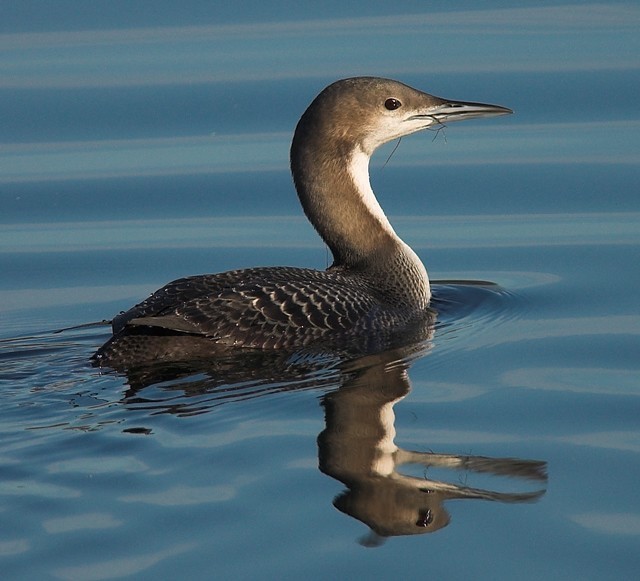Changes to Category A of the British List
The British Ornithologists' Union Records Committee (BOURC) has accepted the following to Category A of the British List:
Pacific Diver Gavia pacifica
Juvenile, near Harrogate, North Yorkshire, 12th January–4th February 2007.
Pacific Diver was recently split from Black-throated Diver Gavia arctica (Knox et al., 2008; Taxonomic recommendations for British birds. Ibis 150, 833–835). It breeds in northern parts of North America and along a narrow coastal strip of northeast Siberia, and winters along the Pacific coast of North America from Alaska to Mexico and in Asia off Japan and south to eastern China.
This bird's arrival at an inland locality made it possible to scrutinise the bird closely and confirm (amongst other features) that the feathers of the anterior tibial tract were dark. The finders are to be congratulated for realising that the bird was not 'just' a Black-throated Diver. There have already been two subsequent records, so this species may have been overlooked previously in circumstances which did not allow the critical features to be rigorously assessed.
It should be placed after Black-throated Diver Gavia arctica on the British List.

Pacific Diver, Farnham GPs, North Yorkshire (Photo: David Moreton)
Yellow-nosed Albatross Thalassarche chlororhynchos
Immature, Brean, Somerset, 29th–30th June 2007; same, Manton, near Messingham Lincolnshire, 2nd–3rd July.
There are two populations of Yellow-nosed Albatross: Atlantic chlororhynchos which is found mainly in the south Atlantic, and Indian bassi which is found mainly in the south-east Indian Ocean.
The bird in Somerset was taken into captivity, and the close-up photographs enabled it to be identified on the basis of the bill pattern and culminicorn shape as Atlantic chlororhynchos, which has also occurred in Norway (on 13th April 1994) and had accumulated 18 records along the Atlantic coast of North America by 1981. Further records would not be surprising, though excellent views and preferably photographs are likely to be required to establish which taxon is involved.
The taxonomy of the Thalassarche albatrosses is currently under review by the BOURC's Taxonomic Sub-committee (TSC).
It should be placed after Black-browed Albatross Thalassarche melanophris on the British List.
Glaucous-winged Gull Larus glaucescens
Third-winter, Gloucester Landfill Site, Hempsted, Gloucestershire, 15th–16th December 2006, trapped, ringed and photographed. Subsequent sightings: Ferryside, Camarthen, 2nd–5th March 2007; Hempsted, Gloucestershire, 16th–17th March; Beddington, London, 18th April.
The normal range of this species extends from the Commander Islands east through the Aleutians, Pribilofs and south Bering Sea to southern Alaska and southeast to north Oregon. It winters from the Bering Sea to northern Japan and Baja California.
Feathers collected from the bird were sent to Prof. P de Knijff (Leiden University) for analysis. The results, which have been deposited with GenBank, clearly placed it in the Beringian clade. Although it was impossible to rule out genetic influence from other taxa with 100% certainty, the bird did not show any features which were demonstrably those of a hybrid, and American expert opinion supported identification as Glaucous-winged Gull.
There had been two previous records in the Western Palearctic, from the Canary Islands and Morocco, and there has already been a subsequent British record.
It should be placed after Iceland Gull Larus glaucoides on the British List.

Glaucous-winged Gull, Beddington SF, Greater London (Photo: Johnny Allan)
White Wagtail Motacilla alba leucopsis
Male, Seaham, County Durham, 5th–6th April 2005.
Colloquially known as Amur Wagtail, this taxon breeds in southeasternmost Russia, south through Ussuriland, northeast China, North and South Korea and southwestern Japan to Taiwan and eastern and southern China. It winters in southern China and southward through Taiwan, Hainan, Indochina, Myanmar, the Andaman Islands, Bangladesh, northern India and Nepal.
This was one of the most remarkable records considered by the Committee in recent years. Although it was considered an unlikely vagrant, no evidence of this taxon in the captive bird trade was found, and there has been a subsequent record from Norway (in November 2008).
Asian Brown Flycatcher Muscicapa dauurica
First-summer, Fair Isle, Shetland, 1st–2nd July 1992.
Nominate dauurica breeds in central Siberia and southeast Russia, northern Mongolia, northeast China, North Korea, Sakhalin and Japan and winters in southern China, southeast Asia, the Philippines and Greater Sundas.
This species has been recognised as a potential vagrant for a long time, and there have been several previous claims. The identity of the Fair Isle bird was never in doubt, and the subsequent occurrence of birds in autumn in 2007 and 2008 prompted a review of this record. Although the date of the record is surprising, it followed a June dominated by continental anticyclonic conditions with an associated easterly airstream. One of several spring Greenish Warblers Phylloscopus trochiloides arrived as late as 30th June, and a Bluethroat Luscinia svecica and two Red-backed Shrikes Lanius collurio arrived on the same day as the Brown Flycatcher. The worn condition of the bird's plumage was consistent with that shown by museum specimens collected in June and July, and no hard evidence of this species in captive bird trade in the UK or elsewhere in Europe has been found.
All the British records have involved nominate dauurica.
It should be placed before Spotted Flycatcher Muscicapa striata on the British List.
Also considered: Brown Shrike Lanius cristatus cristatus
Adult male, Whalsay, Shetland, 19th–24th September 2004.
Nominate cristatus breeds in eastern Siberia from the Russian Altai and Ob river eastwards through northern and eastern Mongolia to the Pacific, and winters from India to Thailand and Malaysia.
There were initially some concerns about excluding the possibility that this bird might be 'confusus', but reference to skins showed that it was a fairly typical example of nominate cristatus.
The British List now stands at 587 species (Category A = 568; Category B = 9; Category C = 10).

British Ornithologists' Union http://www.bou.org.uk//http://www.ibis.ac.uk/
British Birds Rarities Committee http://www.bbrc.org.uk/

